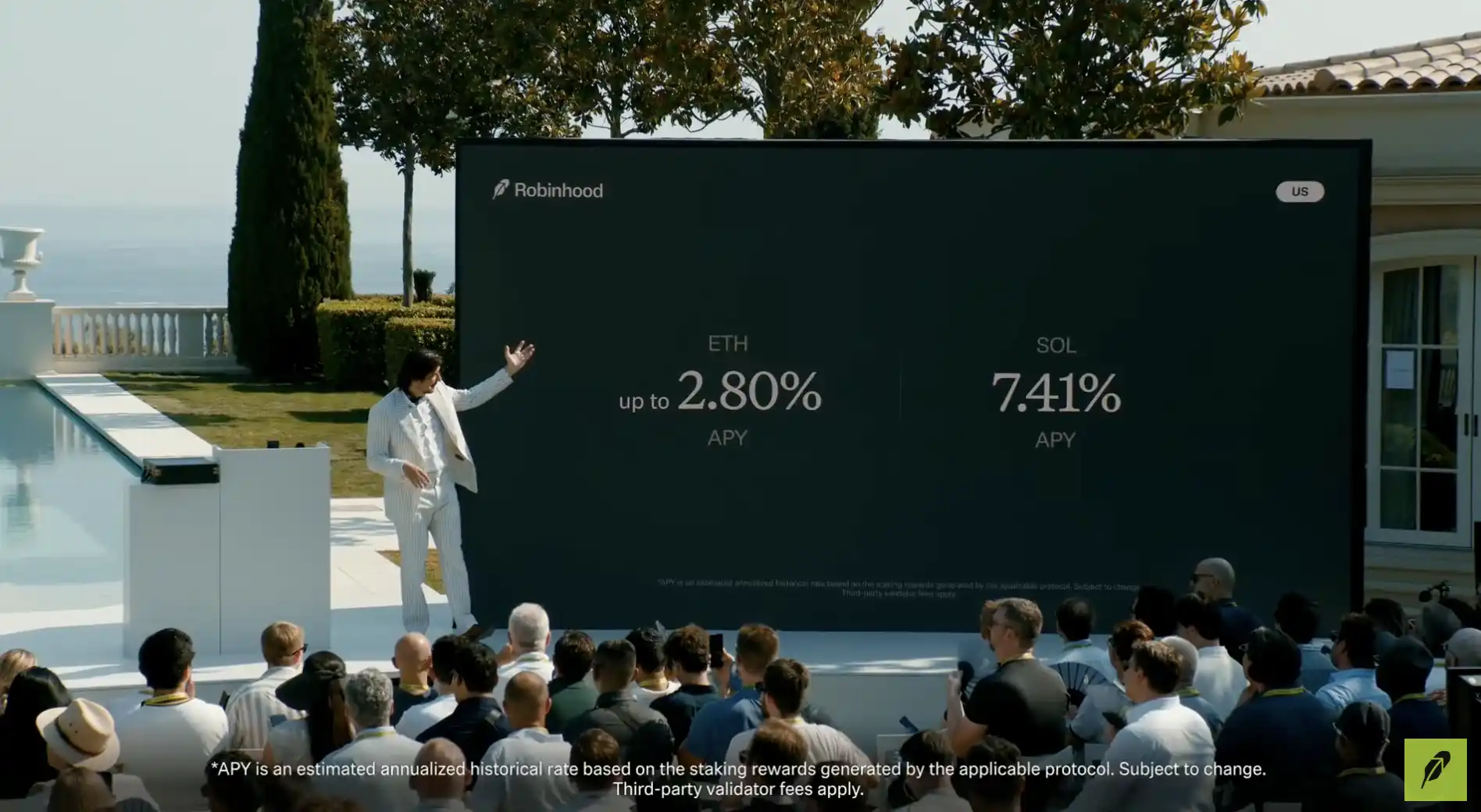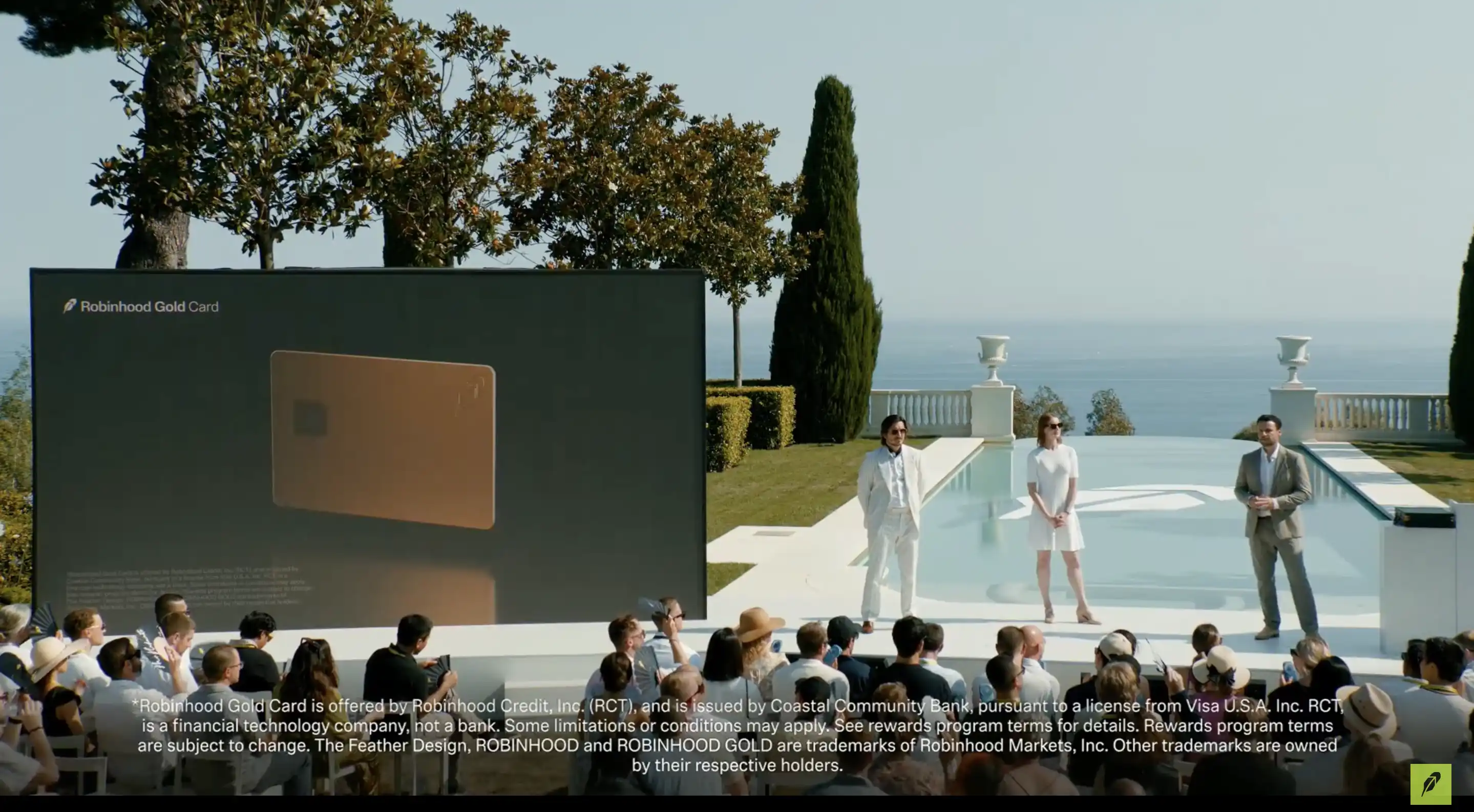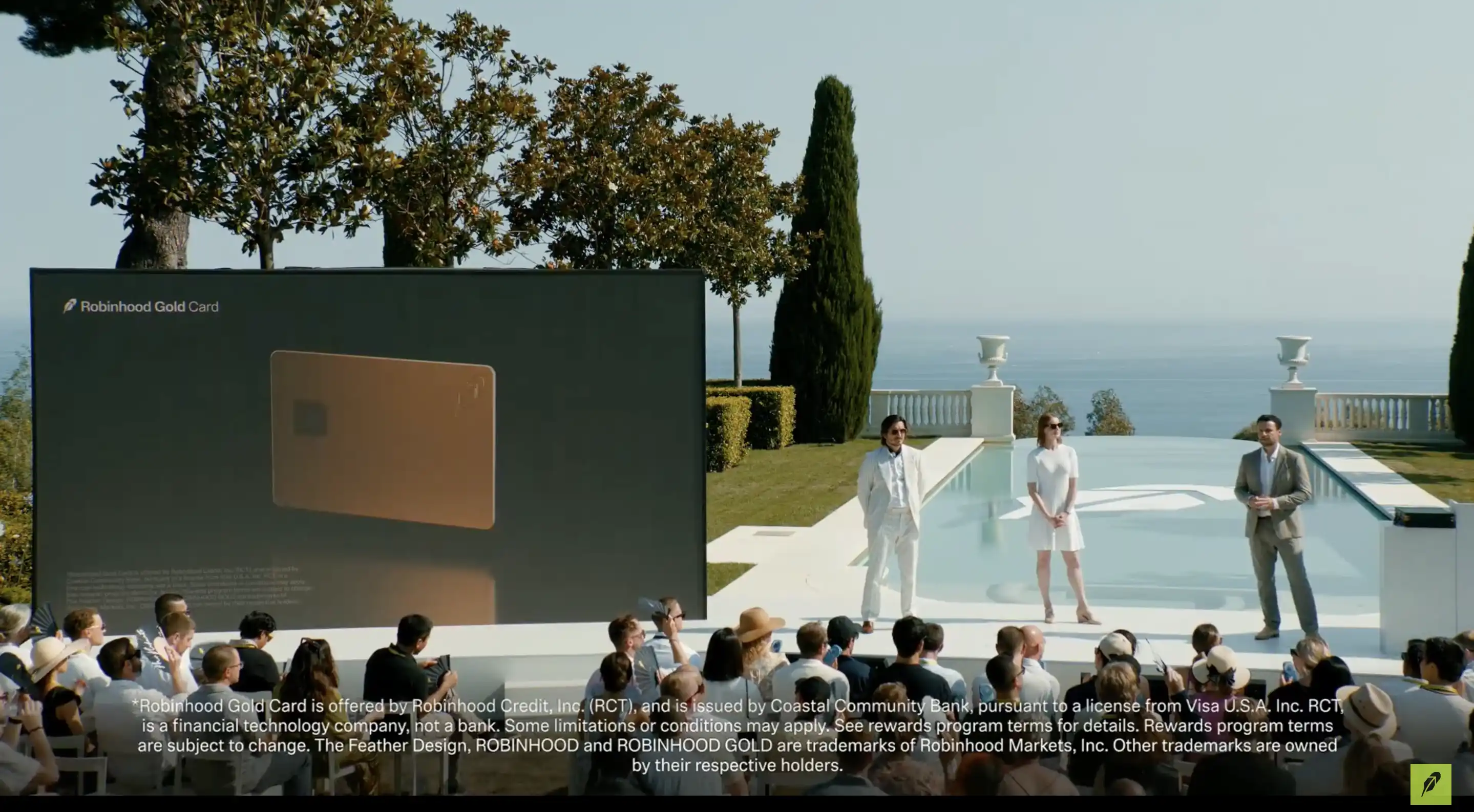
Robinhood's high-profile product launch in Cannes this summer has completely ignited the on-chain brokerage competition.
Could a brokerage firm disrupt not only the commission system but also the underlying architecture of global asset trading? Robinhood seems to have its own answer. At the recently concluded launch event in Cannes, France, the giant that stirred up the U.S. securities industry with zero commissions unveiled an ambitious vision: to comprehensively push stocks, derivatives, and even private equity onto the blockchain through tokenization, and ultimately build a new type of Layer 2 public chain – Robinhood Chain – capable of supporting global real-world assets.
This launch event was more than just a product list; it was Robinhood's declaration of its ten-year plan. The European, American, and global markets were each assigned different breakthrough points, yet they echoed each other, jointly painting a new order of all-weather trading driven by tokenized assets. This article will dissect this "on-chain brokerage" grand strategy in three parts, combining information from Robinhood's on-site launch event with the broader industry context.

Targeting the European Market: Tokenized U.S. Stocks + Perpetual Contracts + All-in-One Investment App
Key Product Information:
1. Robinhood launches tokenized trading of 200+ U.S. stocks and ETFs, based on Arbitrum, with more targets to be added by the end of the year.
2. The European App is upgraded from Robinhood Crypto to "Robinhood," positioned as a comprehensive investment platform.
3. Perpetual contracts will be launched this summer, with simpler mobile-end order placement.
4. Bitstamp serves as the liquidity engine for perpetuals and derivatives.
5. Tokenized stocks support real-time dividend and stock split synchronization.
6. European coverage spans 31 countries, with subscriptions for SpaceX and OpenAI private equity tokens available from July.
Details Worth Noting:
1. Three-Stage Path:
a. TradFi custody → Robinhood mints tokens
b. Bitstamp handles weekend trading → 24/5 liquidity
c. Ultimately supports self-custody and cross-chain functionality
2. Deposit before July 7th to enjoy a 2% bonus
3. App renaming and UI upgrades reinforce the "investment super App" positioning
Robinhood regards European users as the vanguard of its tokenization strategy, and the reasons are not hard to understand: the EU recently implemented MiCA (Markets in Crypto-Assets regulation), which is clearer than U.S. regulation, and Robinhood's penetration rate in the EU is far from saturated.
At the launch event, Robinhood announced that over 200 U.S.-listed stocks and ETFs will be tokenized and traded through Arbitrum Layer 2, allowing European users to buy and sell these tokenized stocks on the Robinhood platform just like trading cryptocurrencies. Since Robinhood also introduced an on-chain synchronized settlement mechanism, rights such as dividends and stock splits will be automatically updated in token holders' accounts. Users don't even need to learn complex blockchain details, seamlessly gaining access to a 24/5 tradable U.S. stock token market.
Robinhood stated that it will continue to expand its tokenized offerings by the end of the year, planning to cover "thousands of U.S. stocks and ETFs." Technically, all transactions at this stage will be completed through Robinhood's cooperation with traditional brokers to purchase stocks and mint equivalent tokens, ensuring a 1:1 real holding ratio. In the future, this process will gradually be migrated to the self-developed Robinhood Chain to achieve cross-chain and self-custody capabilities.
In addition to tokenized stocks, Robinhood also announced the launch of perpetual contract trading (Perpetual Futures) in Europe, with Bitstamp providing transaction matching and clearing support. This is also the first deep integration since Robinhood acquired Bitstamp for $200 million last year. Robinhood particularly emphasized the user experience innovation of perpetual contracts: in the mobile interface, the originally cumbersome margin and stop-loss configurations have been extremely simplified into slider operations, allowing retail investors to get started with advanced leverage tools at a lower threshold.
To echo these major updates, Robinhood renamed its European App from "Robinhood Crypto" to "Robinhood," positioning it as an All-in-One investment super App, integrating cryptocurrencies, tokenized stocks, and perpetual contracts, aiming to establish a first-mover advantage in the 31 EU countries + EEA in one fell swoop.
What surprised the industry the most was Robinhood's announcement of the "private equity token" plan at the event: from July 7th, European Robinhood users will be able to claim the first batch of tokenized equity of SpaceX and OpenAI. This means that Robinhood is taking the lead in breaking the traditional model of private equity being monopolized by the wealthy and institutions for a long time, and opening up shares of the world's most watched technology startups to retail users in the form of tokens.
This idea actually responds to a question that has been mentioned for a long time in the blockchain circle: how can ordinary people fairly participate in the accumulation of future wealth? Robinhood's answer is – private equity should also be tokenized, with equal access.
Targeting the U.S. Market: Advanced Crypto Trading + AI Assistant + staking
Key Product Information:
1. The advanced charts and indicators of the Legend platform will support mobile devices in the future.
2. Launch Smart Exchange Routing to automatically match the lowest rates.
3. Provide precise position selection for convenient tax management.
4. staking is launched in the U.S., initially supporting $ETH and SOL.
5. AI assistant Cortex serves Robinhood Gold users.
6. Rabbit Gold Card will subsequently offer crypto cashback.
7. These features are planned to be extended to Europe in the future.
Details Worth Noting:
1. staking activities offer a 2% bonus and eliminate thresholds.
2. The Cortex information flow includes token dynamics and on-chain events.
3. Smart Routing for large transactions can be as low as 0.1% all-in.
4. staking is positioned as a "community security" participation method.
If Europe is Robinhood's tokenization testing ground, then the United States is undoubtedly its most solid main battlefield with the largest user base. Robinhood used this launch event to simultaneously release product upgrades for the U.S. market, intending to consolidate its position as the "preferred platform for active traders" through in-depth tools and richer investment scenarios.
First, Robinhood announced the launch of staking products in the United States, initially supporting Ethereum and Solana, and eliminating the minimum staking threshold. During the event, users can enjoy a 2% deposit bonus, regardless of the staking amount. Robinhood CEO Vlad Tenev mentioned the other meaning of staking multiple times at the meeting: it is not just a way to earn rewards, but also an opportunity for each user to participate in maintaining network security. He said: "The security of the blockchain comes from people, and staking is also a reflection of Robinhood's desire to include users in the co-construction of the financial system."

In terms of trading tools, Robinhood's flagship product Legend (currently mainly on the desktop) announced that it will migrate advanced charts, custom indicators, and deep order book functions to mobile devices this summer. This move is especially attractive to mobile traders, because in the past, there was a large gap between Robinhood's functions on mobile devices and the professional desktop version.
In conjunction with Legend, Robinhood also launched the Smart Exchange Routing function, which searches for the best liquidity across multiple exchanges and automatically routes it, dynamically calculating fees based on the 30-day rolling transaction volume, which can be as low as 0.1%, while eliminating the traditional maker/taker distinction. This logic is highly similar to the "smart order routing" commonly used in the U.S. stock industry and is a key step for Robinhood to attract large and quantitative crypto traders.
In addition, Robinhood also released the AI investment assistant Cortex at the meeting, which will be available to Robinhood Gold users in the future, providing comprehensive analysis integrating market dynamics, large on-chain transfers, token news, and even company financial reports. Cortex's goal is to help users understand the fundamental reasons for digital asset fluctuations, not just provide simple price alerts.
Finally, the Robinhood Gold credit card (Rabbit Gold Card) will add a "crypto cashback" function, allowing cardholders to automatically convert daily spending cashback into selected cryptocurrencies. Robinhood said that this is an innovation that "breaks the logic of cash cashback," intending to seamlessly connect users' daily life with on-chain asset management.

Overall, Robinhood in the U.S. market is upgrading from a "zero-commission brokerage" to a "one-stop on-chain asset management platform." From staking to AI, from credit cards to smart routing, all reflect Robinhood's further cultivation of user lifecycle management.
Global Strategy: Robinhood Chain + Private Equity Tokens + Full Ecosystem On-Chain
Key Product Information:
1. Robinhood Chain is built on Arbitrum.
2. In the medium term, it can switch between Bitstamp/TradFi liquidity.
3. In the long term, it allows self-custody and cross-chain migration.
Details Worth Noting:
1. SpaceX and OpenAI private equity tokens will be launched first, and private equity tokens are seen as the key to breaking down high-net-worth barriers.
2. Cooperating with regulators to promote compliant on-chain operations, and will be open to developers in the future to promote the RWA ecosystem.
All of the products mentioned above will eventually converge into Robinhood's "global strategy" – Robinhood Chain.
Robinhood Chain, evolved from the Arbitrum technology stack, is positioned by Robinhood as "the first Layer 2 public chain dedicated to real-world assets." It will not only carry Robinhood's tokenized stock trading but also support the tokenization of all categories of real-world assets in the future, including real estate, bonds, art, and carbon credits.
At the launch event, Vlad Tenev gave a "three-stage" plan:
Phase 1: After a user places an order, Robinhood's U.S. broker purchases and custodies the stock from a traditional exchange, and Robinhood generates tokens and distributes them simultaneously, ensuring a 1:1 correspondence with the physical stock.
Phase 2: Bitstamp and TradFi liquidity are integrated to enable continued trading even when traditional stock markets are closed (e.g., weekends, holidays).
Phase 3: Fully unlock the self-custody transfer capability of tokens, allowing users to migrate these Robinhood-generated assets across chains to personal wallets or other DeFi protocols.

In other words, Robinhood Chain is not only Robinhood's own "second-layer settlement network" but will also become a public chain ecosystem open to global developers, allowing third-party projects to issue real-world asset tokens on it.
This model forms a head-on competition with the RWA (Real World Assets) strategy that Coinbase and Kraken have been actively exploring recently. The difference is that Robinhood has brokerage qualifications and starts with U.S. stock tokenization, possessing a complete compliant brokerage link, which can open up compliant channels between traditional finance and blockchain faster than purely exchange-type platforms.
It is especially worth mentioning that Robinhood simultaneously announced the immediate distribution of OpenAI and SpaceX private equity tokens at the event. In the future, these tokens can still flow through Robinhood Chain on weekends, without relying on a single custodian, and allow subsequent free cross-chain use. This attempt may change the liquidity structure of the entire private equity investment industry, just like Robinhood's zero-commission revolution, with extremely disruptive potential.
In the eyes of industry observers, if Robinhood successfully makes Robinhood Chain the base of global real-world assets, not just stocks or futures, including real estate, art, and even carbon emission indicators, may become composable assets in Robinhood users' wallets in the future, which will be a very profound reconstruction of the global financial system.
The Prototype of an On-Chain Brokerage
From zero commissions to U.S. fractional share trading, to today's "Robinhood Chain," Robinhood is writing a highly continuous innovation route: each step is aimed at the thresholds and inefficiencies in the traditional financial system, greatly reducing the barriers to entry through technical means.
When tokenization goes from an Apple stock to a building, a private equity share, or even a work of art, blockchain is no longer just a tool for speculation but truly has the meaning of an "Internet of Assets." Robinhood sees this opportunity and hopes to use its user volume and brand trust to run out first in the window of gradually clarifying regulation.
A report by Ripple and BCG predicts that the global tokenized real-world asset market will reach $18.9 trillion by 2033. Robinhood obviously does not intend to be just an interloper but to become the foundation builder of this market. The declaration at the Cannes launch event may be used as the ending: "The foundation of the future global finance is Robinhood Chain."

Robinhood's high-profile product launch in Cannes this summer has completely ignited the on-chain brokerage competition.
Could a brokerage firm disrupt not only the commission system but also the underlying architecture of global asset trading? Robinhood seems to have its own answer. At the recently concluded launch event in Cannes, France, the giant that stirred up the U.S. securities industry with zero commissions unveiled an ambitious vision: to comprehensively push stocks, derivatives, and even private equity onto the blockchain through tokenization, and ultimately build a new type of Layer 2 public chain – Robinhood Chain – capable of supporting global real-world assets.
This launch event was more than just a product list; it was Robinhood's declaration of its ten-year plan. The European, American, and global markets were each assigned different breakthrough points, yet they echoed each other, jointly painting a new order of all-weather trading driven by tokenized assets. This article will dissect this "on-chain brokerage" grand strategy in three parts, combining information from Robinhood's on-site launch event with the broader industry context.

Targeting the European Market: Tokenized U.S. Stocks + Perpetual Contracts + All-in-One Investment App
Key Product Information:
1. Robinhood launches tokenized trading of 200+ U.S. stocks and ETFs, based on Arbitrum, with more targets to be added by the end of the year.
2. The European App is upgraded from Robinhood Crypto to "Robinhood," positioned as a comprehensive investment platform.
3. Perpetual contracts will be launched this summer, with simpler mobile-end order placement.
4. Bitstamp serves as the liquidity engine for perpetuals and derivatives.
5. Tokenized stocks support real-time dividend and stock split synchronization.
6. European coverage spans 31 countries, with subscriptions for SpaceX and OpenAI private equity tokens available from July.
Details Worth Noting:
1. Three-Stage Path:
a. TradFi custody → Robinhood mints tokens
b. Bitstamp handles weekend trading → 24/5 liquidity
c. Ultimately supports self-custody and cross-chain functionality
2. Deposit before July 7th to enjoy a 2% bonus
3. App renaming and UI upgrades reinforce the "investment super App" positioning
Robinhood regards European users as the vanguard of its tokenization strategy, and the reasons are not hard to understand: the EU recently implemented MiCA (Markets in Crypto-Assets regulation), which is clearer than U.S. regulation, and Robinhood's penetration rate in the EU is far from saturated.
At the launch event, Robinhood announced that over 200 U.S.-listed stocks and ETFs will be tokenized and traded through Arbitrum Layer 2, allowing European users to buy and sell these tokenized stocks on the Robinhood platform just like trading cryptocurrencies. Since Robinhood also introduced an on-chain synchronized settlement mechanism, rights such as dividends and stock splits will be automatically updated in token holders' accounts. Users don't even need to learn complex blockchain details, seamlessly gaining access to a 24/5 tradable U.S. stock token market.
Robinhood stated that it will continue to expand its tokenized offerings by the end of the year, planning to cover "thousands of U.S. stocks and ETFs." Technically, all transactions at this stage will be completed through Robinhood's cooperation with traditional brokers to purchase stocks and mint equivalent tokens, ensuring a 1:1 real holding ratio. In the future, this process will gradually be migrated to the self-developed Robinhood Chain to achieve cross-chain and self-custody capabilities.
In addition to tokenized stocks, Robinhood also announced the launch of perpetual contract trading (Perpetual Futures) in Europe, with Bitstamp providing transaction matching and clearing support. This is also the first deep integration since Robinhood acquired Bitstamp for $200 million last year. Robinhood particularly emphasized the user experience innovation of perpetual contracts: in the mobile interface, the originally cumbersome margin and stop-loss configurations have been extremely simplified into slider operations, allowing retail investors to get started with advanced leverage tools at a lower threshold.
To echo these major updates, Robinhood renamed its European App from "Robinhood Crypto" to "Robinhood," positioning it as an All-in-One investment super App, integrating cryptocurrencies, tokenized stocks, and perpetual contracts, aiming to establish a first-mover advantage in the 31 EU countries + EEA in one fell swoop.
What surprised the industry the most was Robinhood's announcement of the "private equity token" plan at the event: from July 7th, European Robinhood users will be able to claim the first batch of tokenized equity of SpaceX and OpenAI. This means that Robinhood is taking the lead in breaking the traditional model of private equity being monopolized by the wealthy and institutions for a long time, and opening up shares of the world's most watched technology startups to retail users in the form of tokens.
This idea actually responds to a question that has been mentioned for a long time in the blockchain circle: how can ordinary people fairly participate in the accumulation of future wealth? Robinhood's answer is – private equity should also be tokenized, with equal access.
Targeting the U.S. Market: Advanced Crypto Trading + AI Assistant + staking
Key Product Information:
1. The advanced charts and indicators of the Legend platform will support mobile devices in the future.
2. Launch Smart Exchange Routing to automatically match the lowest rates.
3. Provide precise position selection for convenient tax management.
4. staking is launched in the U.S., initially supporting ETH and SOL.
5. AI assistant Cortex serves Robinhood Gold users.
6. Rabbit Gold Card will subsequently offer crypto cashback.
7. These features are planned to be extended to Europe in the future.
Details Worth Noting:
1. staking activities offer a 2% bonus and eliminate thresholds.
2. The Cortex information flow includes token dynamics and on-chain events.
3. Smart Routing for large transactions can be as low as 0.1% all-in.
4. staking is positioned as a "community security" participation method.
If Europe is Robinhood's tokenization testing ground, then the United States is undoubtedly its most solid main battlefield with the largest user base. Robinhood used this launch event to simultaneously release product upgrades for the U.S. market, intending to consolidate its position as the "preferred platform for active traders" through in-depth tools and richer investment scenarios.
First, Robinhood announced the launch of staking products in the United States, initially supporting Ethereum and Solana, and eliminating the minimum staking threshold. During the event, users can enjoy a 2% deposit bonus, regardless of the staking amount. Robinhood CEO Vlad Tenev mentioned the other meaning of staking multiple times at the meeting: it is not just a way to earn rewards, but also an opportunity for each user to participate in maintaining network security. He said: "The security of the blockchain comes from people, and staking is also a reflection of Robinhood's desire to include users in the co-construction of the financial system."

In terms of trading tools, Robinhood's flagship product Legend (currently mainly on the desktop) announced that it will migrate advanced charts, custom indicators, and deep order book functions to mobile devices this summer. This move is especially attractive to mobile traders, because in the past, there was a large gap between Robinhood's functions on mobile devices and the professional desktop version.
In conjunction with Legend, Robinhood also launched the Smart Exchange Routing function, which searches for the best liquidity across multiple exchanges and automatically routes it, dynamically calculating fees based on the 30-day rolling transaction volume, which can be as low as 0.1%, while eliminating the traditional maker/taker distinction. This logic is highly similar to the "smart order routing" commonly used in the U.S. stock industry and is a key step for Robinhood to attract large and quantitative crypto traders.
In addition, Robinhood also released the AI investment assistant Cortex at the meeting, which will be available to Robinhood Gold users in the future, providing comprehensive analysis integrating market dynamics, large on-chain transfers, token news, and even company financial reports. Cortex's goal is to help users understand the fundamental reasons for digital asset fluctuations, not just provide simple price alerts.
Finally, the Robinhood Gold credit card (Rabbit Gold Card) will add a "crypto cashback" function, allowing cardholders to automatically convert daily spending cashback into selected cryptocurrencies. Robinhood said that this is an innovation that "breaks the logic of cash cashback," intending to seamlessly connect users' daily life with on-chain asset management.

Overall, Robinhood in the U.S. market is upgrading from a "zero-commission brokerage" to a "one-stop on-chain asset management platform." From staking to AI, from credit cards to smart routing, all reflect Robinhood's further cultivation of user lifecycle management.
Global Strategy: Robinhood Chain + Private Equity Tokens + Full Ecosystem On-Chain
Key Product Information:
1. Robinhood Chain is built on Arbitrum.
2. In the medium term, it can switch between Bitstamp/TradFi liquidity.
3. In the long term, it allows self-custody and cross-chain migration.
Details Worth Noting:
1. SpaceX and OpenAI private equity tokens will be launched first, and private equity tokens are seen as the key to breaking down high-net-worth barriers.
2. Cooperating with regulators to promote compliant on-chain operations, and will be open to developers in the future to promote the RWA ecosystem.
All of the products mentioned above will eventually converge into Robinhood's "global strategy" – Robinhood Chain.
Robinhood Chain, evolved from the Arbitrum technology stack, is positioned by Robinhood as "the first Layer 2 public chain dedicated to real-world assets." It will not only carry Robinhood's tokenized stock trading but also support the tokenization of all categories of real-world assets in the future, including real estate, bonds, art, and carbon credits.
At the launch event, Vlad Tenev gave a "three-stage" plan:
Phase 1: After a user places an order, Robinhood's U.S. broker purchases and custodies the stock from a traditional exchange, and Robinhood generates tokens and distributes them simultaneously, ensuring a 1:1 correspondence with the physical stock.
Phase 2: Bitstamp and TradFi liquidity are integrated to enable continued trading even when traditional stock markets are closed (e.g., weekends, holidays).
Phase 3: Fully unlock the self-custody transfer capability of tokens, allowing users to migrate these Robinhood-generated assets across chains to personal wallets or other DeFi protocols.

In other words, Robinhood Chain is not only Robinhood's own "second-layer settlement network" but will also become a public chain ecosystem open to global developers, allowing third-party projects to issue real-world asset tokens on it.
This model forms a head-on competition with the RWA (Real World Assets) strategy that Coinbase and Kraken have been actively exploring recently. The difference is that Robinhood has brokerage qualifications and starts with U.S. stock tokenization, possessing a complete compliant brokerage link, which can open up compliant channels between traditional finance and blockchain faster than purely exchange-type platforms.
It is especially worth mentioning that Robinhood simultaneously announced the immediate distribution of OpenAI and SpaceX private equity tokens at the event. In the future, these tokens can still flow through Robinhood Chain on weekends, without relying on a single custodian, and allow subsequent free cross-chain use. This attempt may change the liquidity structure of the entire private equity investment industry, just like Robinhood's zero-commission revolution, with extremely disruptive potential.
In the eyes of industry observers, if Robinhood successfully makes Robinhood Chain the base of global real-world assets, not just stocks or futures, including real estate, art, and even carbon emission indicators, may become composable assets in Robinhood users' wallets in the future, which will be a very profound reconstruction of the global financial system.
The Prototype of an On-Chain Brokerage
From zero commissions to U.S. fractional share trading, to today's "Robinhood Chain," Robinhood is writing a highly continuous innovation route: each step is aimed at the thresholds and inefficiencies in the traditional financial system, greatly reducing the barriers to entry through technical means.
When tokenization goes from an Apple stock to a building, a private equity share, or even a work of art, blockchain is no longer just a tool for speculation but truly has the meaning of an "Internet of Assets." Robinhood sees this opportunity and hopes to use its user volume and brand trust to run out first in the window of gradually clarifying regulation.
A report by Ripple and BCG predicts that the global tokenized real-world asset market will reach $18.9 trillion by 2033. Robinhood obviously does not intend to be just an interloper but to become the foundation builder of this market. The declaration at the Cannes launch event may be used as the ending: "The foundation of the future global finance is Robinhood Chain."
 00:00
00:00